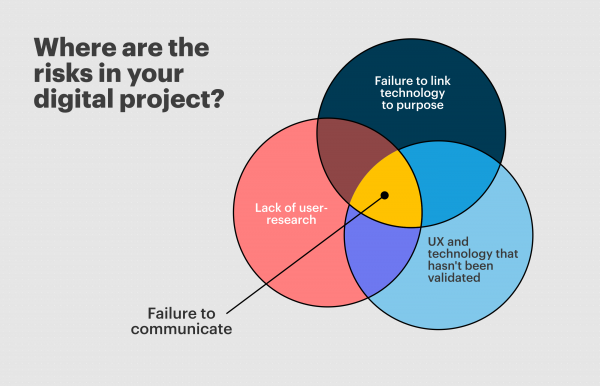Boardroom Premium


Directors are good at managing risk, yet digital projects often produce disappointing results when compared to non-digital projects. Why is that? What makes digital projects riskier?
First, let’s define a ‘digital project’ as being a programme of work that requires you to engage external technology partners to help with delivery.
For example, a membership organisation might redesign its website to make it easier for people to find resources and book training courses. Or a government agency might release a mobile app to make it easier for people to keep track of their health records. Or a manufacturer might set up an online platform and APIs to enable its business customers to order products directly from within the customer’s own stock management tools.
These are all digital projects that required the organisation to bring in technology expertise for delivery. By comparison, if you are a digital-native company like Xero, you don’t have to hire a technology vendor, you are digital by default. You don’t do ‘digital projects’, you just do projects. The word ‘digital’ barely exists inside Xero, like water barely exists to a fish.
For the vast majority of organisations that aren’t digital by default, the business model and risks are different. You can’t compare yourself to Xero or Facebook, nor can you adopt the practices that work for them.
If your digital project is particularly significant to your organisation, perhaps because of the size of the budget, level of risk, or its strategic importance, you should set up a separate digital project committee. The board committee can get closer to the project to better understand the risks and help guide it towards success.
What is significant to one organisation is different to another. A single digital project might not warrant setting up a committee, but complex projects usually require the coordination and oversight of many different workstreams, often requiring integration between different technologies and vendors. It's up to your organisation to assess the risk and significance, however, it's worth considering that digital transformations are really just a coordinated set of digital projects. If you can deliver one digital project well, you're much more likely to be able to deliver a transformation. The sooner your board has experience overseeing digital projects, the better.
On top of the usual resourcing challenges, politics, timelines and capability risks associated with any significant project, here are four areas of risk to consider that are more particular to digital projects.
Are you clear on what the digital project is trying to achieve? Can you directly connect the desired outcome with the technology choices? A project without a clear purpose often results in spending on the wrong things. For example, if the purpose is to enable people to find your organisation more easily online — spending a lot of money on underlying technologies such as a content management system is a poor investment. You should be investing in better content, SEO and online advertising.
As a director, you should expect to see papers that include various technology options that were explored and why one technology or approach was adopted over another. You should be able to draw a direct line between the proposed investment, the technology and the intended outcomes. You need to hold big technology promises to account. How will changing your CRM platform actually increase sales? How will changing your CMS really reduce cybersecurity threats? Where is the proof?
As a director, you’re probably very clear about who your organisation serves. You will know who your stakeholders are and how they engage with you. The audiences for your digital project should be equally clear — who will benefit from this digital project? How will that benefit be realised?
If you are launching a new product, you need to interrogate what research has been undertaken to understand the audience. Do they really want another app? Whey would they move from an existing platform to yours? It’s very easy to assume you know your audience and how they want to use digital channels to engage with you, but that would be a mistake. People behave differently and have very different expectations online.
Equally, if your audience is internal and the project involves changing systems or processes, what work has been done to bring people on the journey? An audience’s resistance to change, or failure to adopt, is a common reason why digital projects fail. If you can’t validate the real needs of your audience at the outset of your digital project, you should be raising a red flag.
The term user-experience (UX) is often used to describe how somebody feels when they use technology. It encompasses the visual design, interface, speed and usefulness of any particular digital product. It’s incredibly important and digital products thrive or dive based on the strength of the user-experience.
As a director, you don’t need to know the ins and outs of what makes a good user experience, but you do need to interrogate the proposed digital project or solution to understand if the user-experience has been tested and validated with real people.
For example, if the digital project promises to increase online bookings by improving the user-experience — has this been validated? Before any code is written, or even before a vendor is chosen, did somebody test different designs or options to validate the core experience? Will the new online booking system really be more useful and usable than the old one?
It’s very easy to ‘sell’ what technology could do, it’s very hard to demonstrate what technology will do. You should look for proof of what the technology will do in the form of working code, demonstrations, prototypes etc. You need to see it to believe it. You need to hold the digital project to account, and ideally, you should put milestones in place that ensure the project doesn’t proceed until the proposed user-experiences and technologies have been validated.
It’s hard to keep up with rapidly changing technology and terminology. Even when the underlying technology isn’t changing, the jargon and language surrounding it is always being updated. This makes clear communication a vital requirement for any digital project to succeed. A good client/vendor relationship is built on quality communication.
If you can’t clearly articulate the project’s purpose and what you want to achieve, you’ll struggle to find the right vendor, and when a technology partner is chosen, it’ll be very hard for them to deliver successful results.
This failure to communicate can’t be fixed through a bigger RFP or a more rigid contract process. In general, the bigger the RFP, the bigger the mess.
As a director on a digital project committee, you should expect clear and succinct communication. If you don’t understand the information you are receiving, ask questions. In my experience, the ‘dumbest’ questions are the best ones — they often cut through the jargon to the core of the issue. If your internal project team can’t explain the jargon to you in a way you understand, there’s a very real risk they’ve been captured by the vendor. In that situation, it’s a good idea to introduce an independent third-party to the project. This person can help translate and ensure you are making informed decisions.
The best digital projects have two clear communicators: one on the client side and one on the vendor side. The job titles of these clear communicators will vary, but they’re always the ones who ‘get it’ and ensure the project goes smoothly. As a director, you should identify these people and help mitigate the risk of one or both of them leaving the project. Turn over of key people at key moments in a digital project can destroy productivity.

If the purpose, audiences, proposed experiences and suggested technology all line up, and you are working with clear communicators and the right technology vendor, your digital project will succeed.
As a director, you can add enormous value by asking good questions and helping to manage the risks in each of these four key areas. If you’re on a board committee overseeing digital work, the closer to the action you are, the better. A digital project can head in the wrong direction very quickly. You could start every meeting by asking: are we on purpose, do we know who we are delivering for, and are the proposed experiences and technology still appropriate?
Also by Tom Hovey:

Tom Hovey MInstD is a creative consultant with over 25 years of digital experience working in New Zealand and the United Kingdom. Tom helps organisations develop digital strategies that deliver meaningful results.
The views expressed in this article do not reflect the position of the IoD unless explicitly stated.
Contribute your perspectives and expertise on an area of governance to the IoD membership and governance community. Contact us mail@iod.org.nz